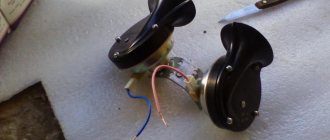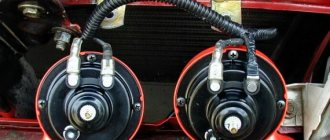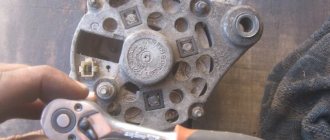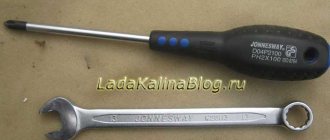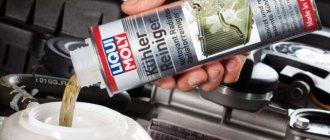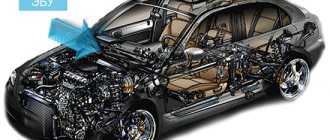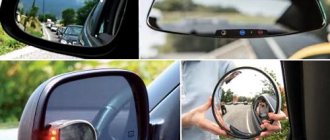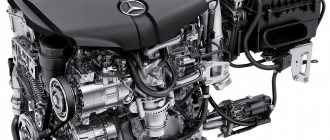I made a powerful steamship whistle from plastic pipes with my own hands. Using various plumbing components you can assemble interesting crafts. For example, a steamship whistle (typhon in English). Moreover, to make a cool signal, I don’t need to weld, solder or glue anything. Read and see below about how to make a beep - a typhon with your own hands. The money spent will be repaid by the results obtained. It is impossible to buy such a beep anywhere - you can only make it yourself. I show you the diagram and secrets of assembling a steamship whistle with your own hands.
Making a pneumatic signal with your own hands
Three powerful pipes You will definitely need to purchase the following elements to create a pneumatic signal with your own hands:
Compressor. Most car enthusiasts in Russia and neighboring countries use products under the Berkut brand. It has several models, the power of the R15 will be enough for you. Solenoid valve. With its help, air is discharged from the receiver into the pipes. It can come with them. For convenience, we recommend purchasing these
However, you can buy the valve separately - then pay attention to the voltage and diameter. Check valve. It is installed at the outlet of the compressor and should not allow air to flow back from the receiver. Pressure switch
Used for this. So that the compressor turns off when the required pressure is reached and turns on again when it drops. Receiver. A 4-liter model with a pressure of 12.5 bar is suitable. It should have two holes - one for connecting the compressor and blower, the other for draining condensate. Pipes.
Also useful are pneumatic connectors (according to the thread size and the size of the holes of the receiver, compressor and pipe) and fittings.
Components for assembling a steamship whistle
The following parts were purchased from a plumbing store:
1. Bend 40 mm - 90° - 4 pieces;
2. Siphon for sink included - 1 piece;
3. Transition 50 mm - 40 mm - 1 piece;
4. Bend 110mm - 87° - 1 piece;
5. Transition 110 mm - 50 mm.
I used a swimming cap as a membrane. Even a piece from a torn cap is enough. Let's start assembling the Typhon.
Sound signal device for VAZ 2107
VAZ 2107 cars are equipped, depending on the year of manufacture, with two versions of the sound alarm. On models since 2000, a sound signal is installed on the VAZ 2107, consisting of two separate devices. One source produces low tones, and the second high. The devices are fixed directly to special brackets and are located on the left side of the radiator, under the grille.
Early models of VAZ 2107 cars are equipped with non-separable sound emission sources that produce only one tone. The product is also mounted on the front part near the radiator. The connection diagram of the element is simple, and in case of failure, eliminating the damage will not be difficult.
The sound signal device for 2 sources has the following form:
The contacts are located on the steering wheel, and when you press the button, they close. Springs with a slip ring are used as contacts. The contact ring is located on the back of the steering wheel and provides high-quality contact when pressing the button. In addition to sources and a button, the design of the VAZ 2107 sound alarm also includes a relay and a fuse. The relay is designed to reduce the amount of current flowing to the device button.
The current level is also monitored by fuse F7, located in the circuit. The size of the fusible link is 20A for injection sevens, as well as 16A for carburetor old versions of the VAZ 2107.
Advantages and disadvantages of a pneumatic signal
We have already listed the advantages of pneumatic signals, but it is not difficult for us to repeat them. A very loud sound level will allow you to become “noticeable” among other motorists on the road, which can prevent an accident. In addition to the pneumatic signal, you also get a standard compressor on the body of your car, which is also not bad at all. The disadvantages of a pneumatic signal include the high cost of the equipment, as well as the complexity of its connection. In addition, working with pneumatics requires high tightness of the connections, otherwise the compressor will be turned on from time to time to pump into the receiver. Such inclusions can significantly drain your battery, especially during long-term parking. In this case, it is better to connect power to the system through a relay that turns on when power appears in the ignition system circuit. In any case, the tightness of such a system will be lost much earlier than the functionality of the standard signal, which will lead to the need to replace the sealing elements and valves in it. That is, we can say about more expensive maintenance. In any case, weighing all the pros and cons and making a choice based on what is a priority for you is only your prerogative.
Side rubber floor mats for Lada Priora, VAZ 2110, 2111, 2112
with 14% discount
Pencil for removing small scratches fix it pro
with 16% discount
Reflectors at the door
How to install Volga signals on a LADA car
All cars have a device for producing sound signals (horn), but its sound does not always suit the owner. This is the main reason for replacing the standard horn with alternative options (for example, with a sound signal from the Volga). Let's look at this improvement in detail.
Nowadays, horns are usually used in pairs. One with a high tone, the other with a low tone. This provides strength and beauty of sound.
You will need to buy:
Installation and connection of a sound signal from the Volga is shown using the example of the Lada Vesta sedan. On other cars (for example, Lada Largus, Granta, Kalina, Priora, Niva 2121 or XRAY) all actions are performed in a similar way.
Pneumatic signal connection
It is turned on separately from the standard horn, by a button on the control panel. To start a powerful compressor, a relay is installed (in the diagram: No. 4). The signal itself is attached to a frame element or underbody protection.
The wiring is neatly laid out in the engine compartment.
The corrugation is lowered to the installation site, the supply wire is connected to the pneumatic compressor.
Why through a relay? A direct connection will melt the signal button after 10 presses: the pneumatic compressor current is about 15 amperes.
Important: Direct power connection (using the car's standard fuses) is not recommended. In the event of a short circuit, you can de-energize important components of the electrical circuit
Any additional device is connected through its own fuse.
Many car enthusiasts are not satisfied with the sound of the factory signal and want to install a pneumatic signal. Nowadays, there is a large selection of signals for a car, and here the choice remains with the consumer. From many listened signals, such as Volgovsky, HELLA, etc. The pneumatic signal still sounds louder.
Installing a pneumatic signal on a VAZ is quite simple, or rather, you can simply connect plus and minus to the compressor from the factory terminals. Next, we connect the “pipe” to the compressor and everything is ready. You can choose the location of the signal at your discretion, both behind the bumper and in the engine compartment, fortunately there is enough space.
Of course, there are some nuances in installing the “pipe”, or rather, these are blown fuses. A standard 10 A fuse usually does not cope with its purpose and, in violation of the vehicle operating rules, it is necessary to install a fuse with a higher rating, at least 15 A. Below is a video example of installing a pneumatic signal.
Also, if you want to get an even louder sound from a pneumatic signal, you can take a compressor for 2 - 3 pipes separately and put it with an adapter on one large pipe. The result will be an even shriller beep.
Assembling the sound unit of the horn
I pulled the rubber onto the siphon, the degree of tension affects the volume and frequency of the sound, as well as the durability of the work. I did a little stretching.
Membrane
The membrane was secured with twine around the perimeter. There should be no folds.
The membrane is fixed
I inserted the cap tightly and secured it with electrical tape. With the installation of the cap, the membrane received protection from accidental damage and the sound became more directional.
Cap installed
I move on to the final assembly of the steamship whistle and the choice of sound tone.
Installing a new sound signal on VAZ 2112, 2111, 2110
The standard factory signal is often very weak and is not enough for other road users to notice the car. It is for this reason that a different signal will be installed, which used to be on the Volga car. Before installation, you must make sure that the noise level is no more than 120 dB, because otherwise there will be problems with maintenance. How to make the beep louder? Should you completely replace the standard system or simply install additional signals in the car's engine compartment?
There are several ways to install a signal from the Volga on a VAZ 2112, 2111, 2110. Simply replacing is not an option. The problem is that two wires are connected to the standard sound signal - positive and negative: ground is supplied through the case, and the positive wire gives direct current and in this case it also powers the radiator fan. In order for the new signal from the Volga to work, only one positive wire is needed. The minus is supplied through the body.
In this case, different current consumptions are also realized here. The standard signal consumes only 5 amperes, and the signal from the Volga consumes 8 amperes. For this reason, you will need to install a 4-pin relay. The relay can be installed in the fuse box or in the engine compartment of the car. To install a relay inside the cabin, you need the sound signal itself, a single-core wire, a wide female terminal, a 4-pin 30 ampere relay and a relay socket to operate. The sound signal is much larger than the standard signal, so in this case it is necessary to install it on the bracket so that the standard sound is not lost. It is best to install the relay in a free fuse block cell.
Pin 85 is used to connect a 13-pin relay (signal switch on the steering wheel). If you look at the diagram, it is indicated in gray-black color, but in the photograph it is white. You need to connect the wire of the 87th contact of the relay to the free space. To supply the positive wire, you must first route the wire of the 'Ш5-6' connector to the 30th contact of the relay and, using a jumper, to contact 86. The plus is supplied when the signal is pressed through contact 87. There is no need to use the red-white wire for the signals, but current is supplied to it and in this case it is better to install insulation on it. There are many advantages to this method: the relay is located in the mounting block and moisture or water will not get there, the factory wiring is located in the engine compartment and in this case the wire will be taken separately and not from the fan.
Now we need to consider the case of installing a relay in the engine compartment. There are many differences here from the first option, because all the work will be carried out in the engine compartment. All the same materials are used, only in this case you will also need to purchase: a hanging fuse, 8 pieces of female terminals, a two-meter plastic tube. The horn can be installed wherever it is convenient and you need to connect it according to one of the circuits. In the first scheme, the current is taken from the fuse block through its own fuse, and in the second scheme, the plus must be taken directly from the battery and through a separate 20 ampere fuse. Many recommend installing Volgov signals on VAZ according to the second scheme.
The relay must be placed where it will not be exposed to moisture or water. It is best to wrap the relay with insulating tape. Using a size 8 wrench, you need to unscrew the 2 bolts securing the radiator grille and unclip the 2 lower latches, remove the grille completely. We remove the standard sound signal and lay the wiring according to a new diagram. All connections must be carefully insulated, and the wire that connects the wires from the signal must be inserted into the corrugation. We install the relay in the desired position and install the radiator grill back.
Instructions for installing an alarm device
Installing this system on your car is carried out in several basic steps.
- First you need to find a place for the compressor. This may not be so simple. Most cars have a space under the bumper where you can place it.
- Remove the compressor from the frame, it is not needed and interferes with installation.
- The pipes can be installed on the radiator cooling system. They and other elements should not interfere with the heat transfer of all elements of the car.
- Now lay the pipes, fittings and valves. To connect the threads of pneumatic tubes, you can use FUM tape.
- Take the wires from the standard power button into the interior.
- Now you need to connect the system to the battery. It is best to do this through an additional relay, so that power is supplied only after the car is ignited.
- Lay air lines up to the air signal.
- You can make a connection through a relay, which will close the contacts of the system toggle switch and control it. It will also be activated from the standard button on the steering wheel.
- Before assembling the car body, check how everything works. Place the air intake fittings higher in the engine compartment. Check how the pressure is maintained.
Removing the Frame from the Compressor
Remember that you can always remove the air hose. It is long enough that you can use it to inflate the tires of any wheel. This is an additional advantage of installing such a signal.
Price issue
Video “Do-it-yourself pneumatic signal”
This video talks about how to install a pneumatic signal with your own hands (the author of the video is dimonchik445).
The all-pervasive horn of a locomotive or heavy-duty truck, warning us of incredible danger, cannot go unnoticed. He instills in us not only a clear warning, but also respect. A kind of reflexive instinct. Every time we hear the sound of a pneumatic signal, we have a desire to be away from the source of its radiation. Nevertheless, we sometimes feel awkward when, glancing at a vehicle emitting this incredible howl, we notice only an ordinary sedan, unremarkable among other cars, or even an SUV
So, it is already clear to everyone that the pneumatic signal is not only a certain element that attracts the attention of onlookers, but also, more importantly, a certain guarantee of your visibility in the event of preventing an accident on the road. Our article will be devoted to the topic of installing a pneumatic signal on a car. It is also worth mentioning that along with the pneumatic signal you will also receive a standardly installed wheel inflation station, because the compressed air receiver is used for the pneumatic signal
The pump and receiver will provide not only the operation of the pneumatic signal, but also, if necessary, inflation of the wheels
It is also worth mentioning that along with the pneumatic signal you will also receive a standardly installed wheel inflation station, because a compressed air receiver is used for the pneumatic signal. The pump and receiver will ensure the operation of not only the pneumatic signal, but also, if necessary, inflating the wheels.
Characteristics of the pneumatic signal
Before moving on to how to make this device with your own hands, you need to understand what a pneumatic signal is. And also, what is its operating principle, what are its functions, design. And of course, the pros and cons of having such a horn on board your car.
Working principle and functions
The operating principle of the device is quite simple. Pressurized air from the compressor moves through the tube. This causes it to vibrate and make sounds of a certain frequency. Due to the certain complexity of the design, the cost of such a device is quite high . If you decide to assemble and install it yourself, you will save some money, but the costs will still be significant.
There are signals with different pipe shapes, as well as signal power, which can reach up to 125 dB (video author - Varan Varan).
Design
This device consists of the compressor itself and a tube. The number of the latter can reach up to three. The increased number of horns allows you to achieve a richer and more powerful sound. However, even with one tube, the pneumatic type signal makes a powerful impression. The design also includes a solenoid valve, a check valve, a pressure switch and a receiver.
Sound signal VAZ 2107
The manufacturer of the VAZ 2107 equipped the car with two versions of the sound signal (S). In the first case, two sound elements (SE) of low and high tonality were installed (signal types S-304 and S-305), which made it possible to obtain a loud and surround sound. These elements were mounted on a metal bracket in the engine compartment near the radiator of the cooling system.
The second option involved installing one ZE type 20.3721–01, also located on a bracket in front of the cooling radiator. All sound elements are non-separable and cannot be repaired.
Purpose of the sound signal
The sound signal is designed to warn road users of danger and prevent accidents. The signal is given by pressing the ZS button, which is located on the steering wheel.
Traffic rules limit the use of ES to two situations.
– to warn other drivers about the intention to overtake outside populated areas;
– in cases where it is necessary to prevent a traffic accident.
Traffic rules of the Russian Federation
https://www.pdd24.com/
In the first case, the vehicle informs the driver of the car being led before the start of the maneuver. The situations that fall under the second paragraph of the traffic rules are more varied. The following options are possible.
There are many such cases. Timely and reasonable use of traffic signals will allow road users to avoid big troubles.
Sound signal device VAZ 2107
The housing of the electronic device contains a metal membrane, which oscillates due to the movements of the metal armature. These vibrations are the source of sound. The armature itself is driven by a magnetic field created by a coil and winding.
The principle of operation of the ZS VAZ 2107 is as follows. The electromagnetic field that occurs when voltage is applied to the coil pushes out the membrane armature, which, in turn, opens the breaker and turns off the coil. As a result, the membrane returns to its original position, and the armature again closes the breaker contacts. As a result of repetition of such cycles, the membrane vibrates, producing sound.
The principle of operation of the VAZ 2107 sound signal
Voltage is supplied to the terminals of the sound elements through a relay designed to close and open an electrical circuit with a high load. This low current controlled relay avoids overloading some controls. Its malfunction can lead to overheating of control buttons and toggle switches and their failure.
When the contacts of the signal activation button are closed, terminal 85 of the relay is connected to ground (the negative terminal of the battery). In this case, positive is constantly supplied from the generator to terminals 86 and 30 of the ZS relay. Terminals 85 and 86 are the negative and positive of the relay coil. When voltage is applied to them, the contact between terminals 30 and 87 is closed. A plus is supplied to the last terminal, which is connected to the positive contact, through the normally open contact. As a result, when the negative contact of the protective element is constantly connected to ground, an audible signal is triggered.
Installation of a pneumatic sound signal on a VAZ 2107
Some car owners install a powerful pneumatic sound signal on the VAZ 2107. Installation of such a device is quite simple. You will need a grinder, a drill and a standard set of plumbing tools.
First you need to determine where the horn and compressor will be located, and then make brackets to mount them. Typically, the pneumatic signal is installed behind a decorative grille in front of the radiator.
Installation is carried out in the following order:
- We make brackets from a suitable material (metal corner or strip).
- We install the brackets on the top panel in front of the cooling radiator in accordance with the dimensions of the pneumatic claxon and the design of its fastenings.
We install the pneumoklaxon on the brackets.
We mount the compressor on the standard signal brackets or on the panel near the radiator.
We connect the horn and the compressor with a hose from the pneumatic signal kit.
We connect power to the pneumoklaxon from the standard AP.
Making a 12 Volt air horn for a car with your own hands: from theory to practice
An air horn on a car serves to attract the attention of road users, especially pedestrians. If the standard signal is not satisfactory, you can replace it or install an additional one. The article discusses the device, the operating principle of the signaling device, and also gives instructions on how to make a 12 Volt air signal for a car with your own hands.
Causes
Let's look at the main reasons why you may need to repair the VAZ 2110 sound signal
- the most common is that the safety device is broken. The breakdown is easy to repair, since the horn itself is not affected;
- short circuit in the vehicle's on-board network;
- Horn malfunction. If the situation has not changed after changing the safety unit, check the operation of the horn by connecting it to the battery. If the structure is not broken, it will indicate this when it receives a signal;
- Perhaps oxidation of the steering wheel elements has occurred. This can cause deposits to appear and the impossibility of transmitting impulse for the harmonious operation of the horn;
- failure (wear) of the contact ring on the steering wheel. Wear is a problem from which no one is immune, so try to maximize the service life by lubricating with graphite lubricant.
The problem may be with the clamping contacts that are worn out. They are located on the steering column. The breakdown is common in domestically produced cars. Graphite lubricant will come to the rescue: if you use it to lubricate parts that are most susceptible to demolition, you can significantly reduce the need to go to a service station.
Sound signal 20.3721 is a device in a car that converts direct current flowing through it into high-power sound radiation of an audible frequency spectrum. It is installed primarily to improve the safety of road users.
Sound signal connection diagram 2110
The vehicle is equipped with a type 20.3721 horn, which is mounted on the radiator frame panel amplifier in the engine compartment of the vehicle. It is activated by the contacts of the central button of the steering wheel. There is a slip ring that is mounted on the steering wheel, and spring-loaded contacts on the steering column switch connector. It is recommended to change the sound signal if it does not produce a sound signal at all or if it cannot be adjusted. Adjustment is made using a screw located on the signal housing, turning the screw in one direction or another.
Before purchasing alternative sound signals, make sure that the signal level is not higher than 120dB, otherwise you will not pass MOT. How to make the sound signal of a VAZ 2110 louder? Well, of course, replace the standard sound signals with louder ones or install additional horns under the hood.
